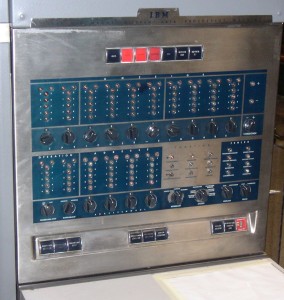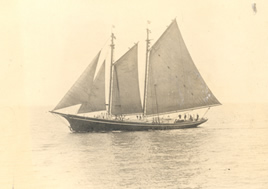|
Cuthbert Hurd
Cuthbert Corwin Hurd (April 5, 1911 – May 22, 1996) was an American computer scientist and entrepreneur, who was instrumental in helping the International Business Machines Corporation develop its first general-purpose computers. Life Hurd was born April 5, 1911, in Estherville, Iowa. He received his B.A. in mathematics from Drake University in 1932, his M.S. in mathematics from Iowa State College in 1934, and his Ph.D. in mathematics from the University of Illinois in 1936. Waldemar Joseph Trjitzinsky was his advisor, and dissertation was ''Asymptotic theory of linear differential equations singular in the variable of differentiation and in a parameter''. He did post-doctorate work at Columbia University and the Massachusetts Institute of Technology (MIT). He was assistant professor at Michigan State University from 1936 to 1942. During World War II Hurd taught at the US Coast Guard Academy with the rank of Lieutenant Commander, and co-authored the textbook for t ... [...More Info...] [...Related Items...] OR: [Wikipedia] [Google] [Baidu] |
US Coast Guard Academy
The United States Coast Guard Academy (USCGA) is a service academy of the United States Coast Guard in New London, Connecticut. Founded in 1876, it is the smallest of the five U.S. service academies and provides education to future Coast Guard officers in one of nine major fields of study. Students are officers-in-training and are referred to as cadets, and upon graduation receive a Bachelor of Science degree and are commissioned as Coast Guard ensigns with a five-year active-duty service obligation, with additional years if the graduate attends flight school or subsequent government-funded graduate school. Out of approximately 250 cadets entering the academy each summer, around 200 graduate. Cadets can choose from among nine majors, with a curriculum that is graded according to their performance in a holistic program of academics, physical fitness, character, and leadership. Cadets are required to adhere to the academy's "Honor Concept," "''Who lives here reveres honor, ho ... [...More Info...] [...Related Items...] OR: [Wikipedia] [Google] [Baidu] |
Aircraft Nuclear Propulsion
The Aircraft Nuclear Propulsion (ANP) program and the preceding Nuclear Energy for the Propulsion of Aircraft (NEPA) project worked to develop a nuclear propulsion system for aircraft. The United States Army Air Forces initiated Project NEPA on May 28, 1946. NEPA operated until May 1951, when the project was transferred to the joint Atomic Energy Commission (AEC)/USAF ANP. The USAF pursued two different systems for nuclear-powered jet engines, the Direct Air Cycle concept, which was developed by General Electric, and Indirect Air Cycle, which was assigned to Pratt & Whitney. The program was intended to develop and test the Convair X-6, but was canceled in 1961 before that aircraft was built. The total cost of the program from 1946 to 1961 was about $1 billion. Types Direct Air Cycle Direct cycle nuclear engines would resemble a conventional jet engine, except that there would be no combustion chambers. The air gained from the compressor section would be sent to a plenum t ... [...More Info...] [...Related Items...] OR: [Wikipedia] [Google] [Baidu] |
New York City
New York, often called New York City or NYC, is the most populous city in the United States. With a 2020 population of 8,804,190 distributed over , New York City is also the most densely populated major city in the United States, and is more than twice as populous as second-place Los Angeles. New York City lies at the southern tip of New York State, and constitutes the geographical and demographic center of both the Northeast megalopolis and the New York metropolitan area, the largest metropolitan area in the world by urban landmass. With over 20.1 million people in its metropolitan statistical area and 23.5 million in its combined statistical area as of 2020, New York is one of the world's most populous megacities, and over 58 million people live within of the city. New York City is a global cultural, financial, entertainment, and media center with a significant influence on commerce, health care and life sciences, research, technology, educa ... [...More Info...] [...Related Items...] OR: [Wikipedia] [Google] [Baidu] |
IBM SSEC
The IBM Selective Sequence Electronic Calculator (SSEC) was an electromechanical computer built by IBM. Its design was started in late 1944 and it operated from January 1948 to August 1952. It had many of the features of a stored-program computer, and was the first operational machine able to treat its instructions as data, but it was not fully electronic. Although the SSEC proved useful for several high-profile applications, it soon became obsolete. As the last large electromechanical computer ever built, its greatest success was the publicity it provided for IBM. History During World War II, International Business Machines Corporation (IBM) funded and built an Automatic Sequence Controlled Calculator (ASCC) for Howard H. Aiken at Harvard University. The machine, formally dedicated in August 1944, was widely known as the Harvard Mark I. The President of IBM, Thomas J. Watson Sr., did not like Aiken's press release that gave no credit to IBM for its funding and engineering effort. ... [...More Info...] [...Related Items...] OR: [Wikipedia] [Google] [Baidu] |
Nuclear Physics
Nuclear physics is the field of physics that studies atomic nuclei and their constituents and interactions, in addition to the study of other forms of nuclear matter. Nuclear physics should not be confused with atomic physics, which studies the atom as a whole, including its electrons. Discoveries in nuclear physics have led to applications in many fields. This includes nuclear power, nuclear weapons, nuclear medicine and magnetic resonance imaging, industrial and agricultural isotopes, ion implantation in materials engineering, and radiocarbon dating in geology and archaeology. Such applications are studied in the field of nuclear engineering. Particle physics evolved out of nuclear physics and the two fields are typically taught in close association. Nuclear astrophysics, the application of nuclear physics to astrophysics, is crucial in explaining the inner workings of stars and the origin of the chemical elements. History The history of nuclear physics as a di ... [...More Info...] [...Related Items...] OR: [Wikipedia] [Google] [Baidu] |
Punched Card
A punched card (also punch card or punched-card) is a piece of stiff paper that holds digital data represented by the presence or absence of holes in predefined positions. Punched cards were once common in data processing applications or to directly control automated machinery. Punched cards were widely used through much of the 20th century in the data processing industry, where specialized and increasingly complex unit record machines, organized into semiautomatic data processing systems, used punched cards for data input, output, and storage. The IBM 12-row/80-column punched card format came to dominate the industry. Many early digital computers used punched cards as the primary medium for input of both computer programs and data. While punched cards are now obsolete as a storage medium, as of 2012, some voting machines still used punched cards to record votes. They also had a significant cultural impact. History The idea of control and data storage via punched hol ... [...More Info...] [...Related Items...] OR: [Wikipedia] [Google] [Baidu] |
IBM 602
The IBM 602 Calculating Punch, introduced in 1946, was an electromechanical calculator capable of addition, subtraction, multiplication, and division. The 602 was IBM's first machine that did division. (The IBM 601, introduced in 1931, only multiplied.) Like other IBM calculators, it was programmed using a control panel. Input data was read from a punched card, the results could be punched in the same card or a trailing card. The 602 was available in four models: Model 1, Model 2, Model 50, and Model 51. The "Series 50" models were low-cost versions that ran at a slower speed, with half as many program steps, and fewer storage registers and counters. Two additional counters were available as an optional feature. Program steps execute in one machine cycle, except for steps performing multiplication or division which take as many machine cycles as needed for the operation. Punching rate is roughly four columns per machine cycle. The total number of machine cycles required per ... [...More Info...] [...Related Items...] OR: [Wikipedia] [Google] [Baidu] |
Alston Scott Householder
Alston Scott Householder (5 May 1904 – 4 July 1993) was an American mathematician who specialized in mathematical biology and numerical analysis. He is the inventor of the Householder transformation and of Householder's method. Career Householder was born in Rockford, Illinois, USA. He received a BA in philosophy from the Northwestern University of Evanston, Illinois in 1925, and an MA, also in philosophy, from Cornell University in 1927. He taught mathematics while preparing for his PhD, which was awarded at the University of Chicago in 1937. His thesis dealt with the topic of the calculus of variations. After receiving his doctorate, Householder concentrated on the field of mathematical biology, working with several other researchers with Nicolas Rashevsky at the University of Chicago. In 1946, Householder joined the Mathematics Division of the Oak Ridge National Laboratory, where he was appointed chair in 1948; it is during this period that his interests shift towar ... [...More Info...] [...Related Items...] OR: [Wikipedia] [Google] [Baidu] |
Oak Ridge National Laboratory
Oak Ridge National Laboratory (ORNL) is a U.S. multiprogram science and technology national laboratory sponsored by the U.S. Department of Energy (DOE) and administered, managed, and operated by UT–Battelle as a federally funded research and development center (FFRDC) under a contract with the DOE, located in Oak Ridge, Tennessee. Established in 1943, ORNL is the largest science and energy national laboratory in the Department of Energy system (by size) and third largest by annual budget. It is located in the Roane County section of Oak Ridge, Tennessee. Its scientific programs focus on materials, nuclear science, neutron science, energy, high-performance computing, systems biology and national security, sometimes in partnership with the state of Tennessee, universities and other industries. ORNL has several of the world's top supercomputers, including Frontier, ranked by the TOP500 as the world's most powerful. The lab is a leading neutron and nuclear power rese ... [...More Info...] [...Related Items...] OR: [Wikipedia] [Google] [Baidu] |
United States Atomic Energy Commission
The United States Atomic Energy Commission (AEC) was an agency of the United States government established after World War II by U.S. Congress to foster and control the peacetime development of atomic science and technology. President Harry S. Truman signed the McMahon/Atomic Energy Act on August 1, 1946, transferring the control of atomic energy from military to civilian hands, effective on January 1, 1947. This shift gave the members of the AEC complete control of the plants, laboratories, equipment, and personnel assembled during the war to produce the atomic bomb. An increasing number of critics during the 1960s charged that the AEC's regulations were insufficiently rigorous in several important areas, including radiation protection standards, nuclear reactor safety, plant siting, and environmental protection. By 1974, the AEC's regulatory programs had come under such strong attack that the U.S. Congress decided to abolish the AEC. The AEC was abolished by the ... [...More Info...] [...Related Items...] OR: [Wikipedia] [Google] [Baidu] |
Union Carbide
Union Carbide Corporation is an American chemical corporation wholly owned subsidiary (since February 6, 2001) by Dow Chemical Company. Union Carbide produces chemicals and polymers that undergo one or more further conversions by customers before reaching consumers. Some are high-volume commodities and others are specialty products meeting the needs of smaller markets. Markets served include paints and coatings, packaging, wire and cable, household products, personal care, pharmaceuticals, automotive, textiles, agriculture, and oil and gas. The company is a former component of the Dow Jones Industrial Average. Founded in 1917 as the Union Carbide and Carbon Corporation, from a merger with National Carbon Company, the company's researchers developed an economical way to make ethylene from natural gas liquids, such as ethane and propane, giving birth to the modern petrochemical industry. The company divested consumer products businesses Eveready and Energizer batteries, Glad bag ... [...More Info...] [...Related Items...] OR: [Wikipedia] [Google] [Baidu] |




.jpg)

.jpg)


